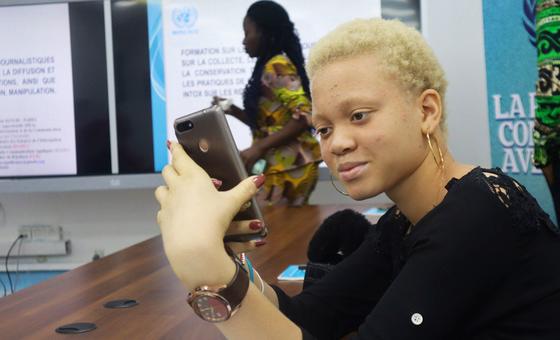Designing ways to fight back against falsehoods that can trigger tensions, violence, or even death, the UN has been monitoring how mis- and disinformation and hate speech can attack health, security, stability as well as progress towards the Sustainable Development Goals (SDGs).
“It has become clear that business as usual is not an option,” UN Secretary-General António Guterres said in a policy brief launched in June on information integrity on digital platforms.
“The ability to disseminate large-scale disinformation to undermine scientifically established facts poses an existential risk to humanity and endangers democratic institutions and fundamental human rights,” he wrote in the brief.
Countering deadly disinformation
Disinformation can be dangerous in other ways. Several UN missions have reported social media campaigns in recent years targeting their peacekeeping work.
In 2019, the UN mission in the Democratic Republic of the Congo (DRC), known by its French acronym MONUSCO, raised grave concerns about social media disinformation campaigns calling for violence against peacekeepers during an Ebola epidemic and following a deadly attack by an armed group in the restive eastern region.
By 2022, the Security Council had adjusted the mandates of its four largest peacekeeping operations – DRC, Central African Republic (CAR), Mali, and South Sudan – and added the task of preventing disinformation campaigns aimed at undermining a mission’s credibility
“This is a war that is going on through social media, the radio, and traditional news outlets,” said Bintou Keita, who heads MONUSCO. Fighting deadly disinformation has been a “painful curve” to learn of this new battlefield, but the mission has now become proactive on social and other media platforms, to help stop its spread, she added.
Digital army fights fake news

Weapons and ammunition is collected during a demobilization process in the Democratic Republic of the Congo.
To fight back against disinformation, UN peacekeepers are putting new tools into the hands of civilians of all ages, including 15-year-old Blessing Kasasi in DRC.
An activist advocating for the rights of women and children, Ms. Kasasi readily joined a workshop in the capital city of Kinshasa, with 30 young people who learned about detecting “fake news” and countering it with the most effective weapon: the truth.
Guillaume Kingh-Farel, one of the workshop trainers, said disinformation is “used as a weapon of war to undermine MONUSCO’s peace efforts in the DRC”.
As such, the MONUSCO-supported workshop to train “a digital army capable of detecting false information” by producing content with the help of a smartphone and editing software and simultaneously spreading objective, credible information through “relay clubs” that disseminate these messages through their networks.
“From a smartphone, I will produce videos to echo good information,” Ms. Kasasi said after the workshop.
Setting the stage
For UN peace operations, some communities they engage are welcoming the new approaches this summer.
In Mali, where a transitional Government has been in power since a coup in 2021, the UN mission, MINUSMA, hosted the first of its kind blogger festival, attracting nearly 400 participants in Mopti in early June.
“With the advance of technology, digital media is increasingly being used to spread misinformation,” said a popular local blogger who attended the event. “A festival to combat misinformation is an innovative approach to overcome this challenge, a useful means for deconstructing hate speech and fake news.”
By the end of June, at the Malian Government’s request, the UN Security Council terminated the mission, which is slated for a complete withdrawal from the country by 1 January 2024.
Other efforts are unfolding elsewhere. In early August, in Abyei, a contested zone straddling Sudan and South Sudan, the UN mission there, UNISFA, launched Voice of Peace, an internet radio station aimed at countering hate speech, and fake news.
Meanwhile, in DR Congo, MONUSCO’s initiatives continue to reach communities plagued by disinformation-triggered tensions. This includes recruiting digital experts, building multimedia products, and reaching out to communities, especially social media savvy youth, mission chief Ms. Keita said.
With these tools, she said MONUSCO has been trying to “beef up our capacity to monitor and to be present on digital platforms in such a way that we are not going to always be in a reactive mode, but in an anticipatory mode”.
UNESCO MIL CLICKS – 10 Points to Detect Disinformation
How can you spot and counter disinformation online?
The UN Verified initiative launched a free online course on how to stay safe from dangerous disinformation circulating on social media. Here are some of the lessons covered:
✔️ Recognize disinformation and why it spreads.
✔️ Recognize emotional, dramatic, and provocative content.
✔️ Understand the danger of fabricated claims and selective evidence.
✔️ Protect yourself from bots and trolls.
✔️ Spot hacked accounts and protect your own accounts.

